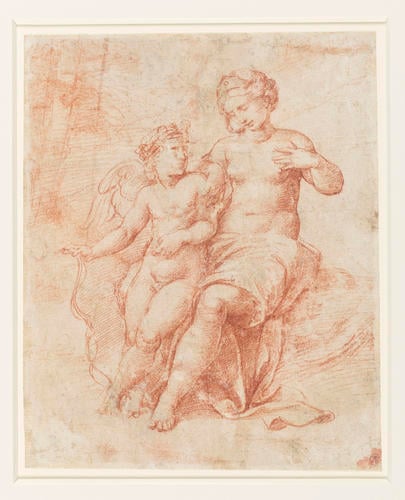Venus and Cupid 1516
Red chalk over stylus underdrawing | 21.1 x 17.2 cm (sheet of paper) | RCIN 912757

Attributed to Giulio Romano (Rome c. 1499-Mantua 1546)
Venus and Cupid 1516
-
The composition corresponds with that of a fresco on the south wall of the Stufetta (heated bathroom) of Bernardo Dovizi (1470-1520), Cardinal Bibbiena, on the third floor of the Vatican palace, Rome. Letters sent by Cardinal Bembo to Bibbiena, who was then absent from Rome, relate the progress of the decorations, painted by Raphael's assistants (none of whom is mentioned by name) and completed in June 1516 (Golzio, Raffaello nei documenti…, 1936, pp. 48ff). These letters establish that the sequence of small frescoes was designed by Raphael to Bibbiena's specifications, on the theme of Venus to complement a small antique statue of the goddess that was intended to fill a niche in the Stufetta, but was never installed.
The handling of the drawing is too superficial to be by Raphael himself. Although there is stylus underdrawing that appears experimental in places, the drawing must depend on the design of another, for the draftsman has misunderstood the position of Venus's right arm, with the upper and lower arm are out of alignment, despite an attempted correcting stroke of chalk in the angle above the wrist. The drawing is however too lively to be a straightforward copy, having none of the mechanical shading seen for example in a version in the Albertina that almost certainly copies the present sheet (Birke & Kertesz, Die Italienischen Zeichnungen der Albertina, 1992-7, I, no. 215). It therefore seems plausible that Raphael provided a sketch for the composition, and that this is a workshop development that served as the definitive model for the fresco, although it bears no evidence of mechanical transference such as squaring.
It is probable that more than one of Raphael's assistants were involved in the painting of the stufetta; the frescoes are usually attributed to Giulio Romano, but their ruined state makes any attribution on grounds of style impossible. The present drawing has also been generally attributed to Giulio, and the linearity and insistence on flat pattern of the better preserved parts of the sheet support this - as do two other studies for the project, en suite with the present, for Pan and Syrinx (Louvre; Cordellier & Py, Raphael, 1992, no. 478) and Venus and Adonis (Albertina; Birke & Kertesz, IV, no. 17632). A red chalk offset in the British Museum records a highly finished study of Venus Anadyomene that appears to have been by a different, less idiosyncratic hand (Pouncey & Gere 1962, no. 282).
Two fragments of cartoons in the Albertina and the British Museum correspond with the heads of Venus in Venus and Adonis and Venus and Cupid respectively, but on a larger scale than in the stufetta (Birke & Kertesz 17633; Pouncey & Gere 50). These cartoons do however agree in scale with a series of frescoes repeating the compositions of the Stufetta, detached from the loggia of the Villa Stati, Rome, and now in the Hermitage, St Petersburg. These frescoes have been heavily overpainted, and thus the contours do not correspond exactly with those of the cartoons; nor can the original authorship of the frescoes themselves be determined. The London cartoon is weak in handling but the Vienna fragment is clearly by Giulio, and as Cristoforo Stati was a patron of Giulio in the early 1520s it seems probable that the cycle in the Villa Stati was executed by Giulio and his assistants shortly after Raphael's death, reusing the compositions from the stufetta of Bibbiena (who had died in 1520 and thus could not have objected to this recycling of ‘his’ designs).
The figure of Venus was closely based on an antique sculpture of a seated Venus, which in its unrestored state lacked its head, right arm, left forearm and left foot, but in which the organisation of the drapery and disposition of the legs is very similar (P.P. Bober and R. Rubinstein, Renaissance Artists and Antique Sculpture, 1986, p.62).
The present drawing also seems to have served as the model for an engraving by Agostino Veneziano (Bartsch XIV, p.218, no. 286), with the addition of a landscape background unrelated to that in the fresco - in fact all but one of the Stufetta compositions were engraved by Agostino, Marcantonio Raimondi or Marco Dente da Ravenna. The scale of the print is smaller that that of the drawing, and numerous differences of detail and proportion suggest that the design was transferred freehand rather than mechanically. The print of Venus and Cupid is dated 1516, the year of the Stufetta's execution, and although Raphael is not credited as the inventor on any of these engravings it is probable that they were produced with his cooperation.
Text adapted from M. Clayton, Raphael and his Circle, 1999, no. 30.Provenance
First recorded in George III's 'Inventory A', c.1810, p. 51, Raffaello d'Urbino e Scuola, no. 31: 'Venus & Cupid, Red Chalk'.
-
Creator(s)
-
Medium and techniques
Red chalk over stylus underdrawing
Measurements
21.1 x 17.2 cm (sheet of paper)
Object type(s)
Other number(s)







